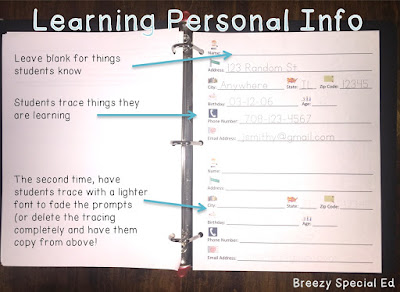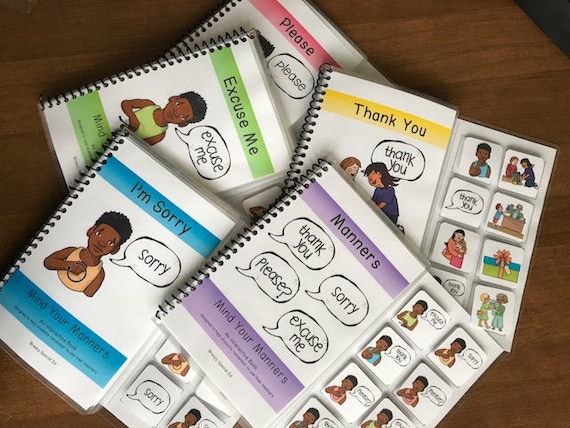No matter where your students are at, they can (and should be) working on their personal information!
I love using personal information as an IEP goal, or an objective. It is an essential life skill and ties into language arts/speaking/writing standards as well.
(You will notice a lot of my objectives are separated by letters. I like to separate sections of the objectives by letters so that I can be even more specific on how a student is performing on a skill without making it two objectives, so for example, I can say "Student is currently at 70% accuracy for tracing his first and last name. A) Student traces his first name with 90% accuracy, about one in every ten times he will forget or skip a letter. B) Student traces his last name with 50% accuracy, usually getting the first couple letters correct.")
Here are some of the phrases I have used in my objectives (of course with the "By ____, Student will.... with __% accuracy, __ out of __ trials.")
- Student will trace his a) first name and b) last name
- Student will match his personal information (a. name, b. address - street name. c. city, d. state, e. zip code, f. birthdate, g. age) with the appropriate section of a form.
- Student will be able to produce an ID card with his personal information in response to a personal information question such as “Can I see your ID” or “What is your address?”
- Given the following personal information: name, birthday, and age, student will a) trace personal information b) copy personal information c) write personal information without a model.
- Student will complete a form using her personal information (a. name, b. birth date, c. address, d. phone number)
Practicing Personal Information Daily
One of the times we practice personal information is during our morning work or binder time. Each of my students have a form in their binders that they use to practice the personal information that relates to their IEP goal or what they need to work on.
Some of these personal info worksheets are laminated with velcro so that students can match their personal information, other worksheets are laminated and students can use a dry erase marker for something like tracing their name, and still other worksheets are simply printed on paper so a students can practice filling in a form with a pencil and also so that I can continuously adjust what information they are working on.
One of the times we practice personal information is during our morning work or binder time. Each of my students have a form in their binders that they use to practice the personal information that relates to their IEP goal or what they need to work on.
Some of these personal info worksheets are laminated with velcro so that students can match their personal information, other worksheets are laminated and students can use a dry erase marker for something like tracing their name, and still other worksheets are simply printed on paper so a students can practice filling in a form with a pencil and also so that I can continuously adjust what information they are working on.
Ways to Fade Prompts and Teach Independence
When a student is working on memorizing their personal information, I usually start with them writing the information they know without a model (such as their name), and then the information they are learning with a light tracing font. I will then physically fade the tracing font to a lighter shade of gray as the student gets more practice.
Also, for each worksheet/form, students practice writing their information more than once, so I might have them trace it the first time, but then the next time it will be blank, so they can look up at the previous information to copy it, but will start learning the information as they do so!
Practice Filling Out Forms Electronically!
Google forms are easy to make and great to use when collecting data! I made a few different google forms that I can easily customize for my students needs. One is all typing, the other is a combination of typing and drop-downs (for example, to choose state or birthday month), and the final one is multiple choice for my students who are still working on recognizing and choosing their own personal information. Check out this YouTube video on how to edit these to use for your students. And the data sheets, done automatically, I LOVE GOOGLE! :)
Non-writing Ways to Practice Personal Information
Our students who aren't able to write need to know their personal info too! You can program their personal information onto their devices and ask them questions to practice answering using their communication system.
You can also print out an ID card for them to carry in their wallet, and ask questions such as "what is your name?" or "what is your address" and have them respond by having over the card (or if they have a state ID they can use, even better! I always recommend to my student's parents to get one of these for their child. Disabled IDs are FREE and great to have, especially if a kid gets lost or gets into a situation and doesn't know how to respond).
I have also worked on recognizing their name in a simple, "my name" and "not my name" sort. You can also have students match their personal information (cut out in strips and laminated with Velcro) to a Velcro-ed form!
If you want some editable personal info forms that are ready to go, check these personal info sheets out! What other suggestions do you have for teaching students their personal information?
Also, for each worksheet/form, students practice writing their information more than once, so I might have them trace it the first time, but then the next time it will be blank, so they can look up at the previous information to copy it, but will start learning the information as they do so!
Practice Filling Out Forms Electronically!
Google forms are easy to make and great to use when collecting data! I made a few different google forms that I can easily customize for my students needs. One is all typing, the other is a combination of typing and drop-downs (for example, to choose state or birthday month), and the final one is multiple choice for my students who are still working on recognizing and choosing their own personal information. Check out this YouTube video on how to edit these to use for your students. And the data sheets, done automatically, I LOVE GOOGLE! :)
Non-writing Ways to Practice Personal Information
Our students who aren't able to write need to know their personal info too! You can program their personal information onto their devices and ask them questions to practice answering using their communication system.
You can also print out an ID card for them to carry in their wallet, and ask questions such as "what is your name?" or "what is your address" and have them respond by having over the card (or if they have a state ID they can use, even better! I always recommend to my student's parents to get one of these for their child. Disabled IDs are FREE and great to have, especially if a kid gets lost or gets into a situation and doesn't know how to respond).
I have also worked on recognizing their name in a simple, "my name" and "not my name" sort. You can also have students match their personal information (cut out in strips and laminated with Velcro) to a Velcro-ed form!
If you want some editable personal info forms that are ready to go, check these personal info sheets out! What other suggestions do you have for teaching students their personal information?













I love the way you have your objectives differentiated by letters- that makes so much sense! Teaching kids how to fill in forms is such an important skill!
ReplyDelete-Maria